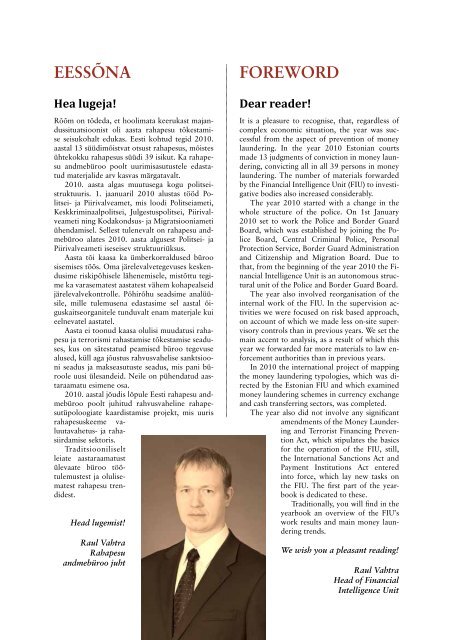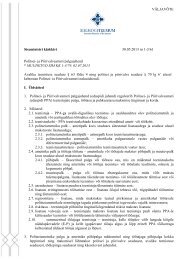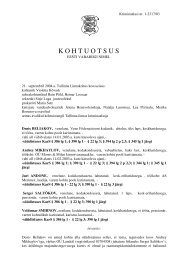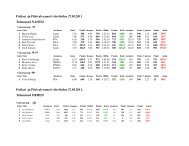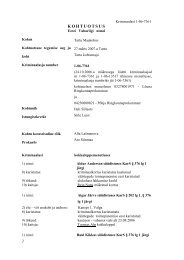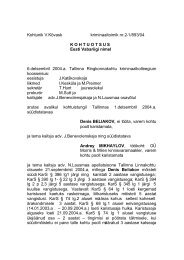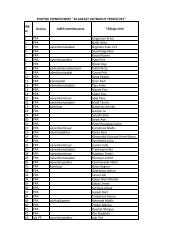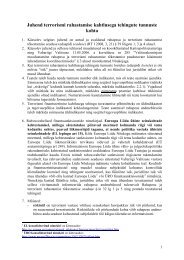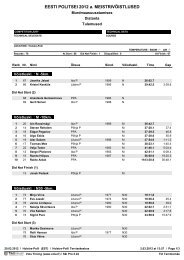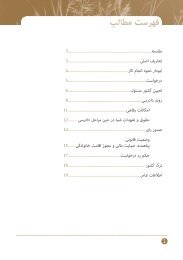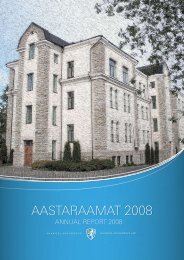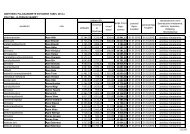Rahapesu andmebüroo aastaraamat 2010 - Politsei
Rahapesu andmebüroo aastaraamat 2010 - Politsei
Rahapesu andmebüroo aastaraamat 2010 - Politsei
Create successful ePaper yourself
Turn your PDF publications into a flip-book with our unique Google optimized e-Paper software.
EESSÕNA<br />
Hea lugeja!<br />
Rõõm on tõdeda, et hoolimata keerukast majandussituatsioonist<br />
oli aasta rahapesu tõkestamise<br />
seisukohalt edukas. Eesti kohtud tegid <strong>2010</strong>.<br />
aastal 13 süüdimõistvat otsust rahapesus, mõistes<br />
ühtekokku rahapesus süüdi 39 isikut. Ka rahapesu<br />
<strong>andmebüroo</strong> poolt uurimisasutustele edastatud<br />
materjalide arv kasvas märgatavalt.<br />
<strong>2010</strong>. aasta algas muutusega kogu politseistruktuuris.<br />
1. jaanuaril <strong>2010</strong> alustas tööd <strong>Politsei</strong>-<br />
ja Piirivalveamet, mis loodi <strong>Politsei</strong>ameti,<br />
Keskkriminaalpolitsei, Julgestuspolitsei, Piirivalveameti<br />
ning Kodakondsus- ja Migratsiooniameti<br />
ühendamisel. Sellest tulenevalt on rahapesu <strong>andmebüroo</strong><br />
alates <strong>2010</strong>. aasta algusest <strong>Politsei</strong>- ja<br />
Piirivalveameti iseseisev struktuuriüksus.<br />
Aasta tõi kaasa ka ümberkorraldused büroo<br />
sisemises töös. Oma järelevalvetegevuses keskendusime<br />
riskipõhisele lähenemisele, mistõttu tegime<br />
ka varasematest aastatest vähem kohapealseid<br />
järelevalvekontrolle. Põhirõhu seadsime analüüsile,<br />
mille tulemusena edastasime sel aastal õiguskaitseorganitele<br />
tunduvalt enam materjale kui<br />
eelnevatel aastatel.<br />
Aasta ei toonud kaasa olulisi muudatusi rahapesu<br />
ja terrorismi rahastamise tõkestamise seaduses,<br />
kus on sätestatud peamised büroo tegevuse<br />
alused, küll aga jõustus rahvusvahelise sanktsiooni<br />
seadus ja makseasutuste seadus, mis pani büroole<br />
uusi ülesandeid. Neile on pühendatud <strong>aastaraamat</strong>u<br />
esimene osa.<br />
<strong>2010</strong>. aastal jõudis lõpule Eesti rahapesu <strong>andmebüroo</strong><br />
poolt juhitud rahvusvaheline rahapesutüpoloogiate<br />
kaardistamise projekt, mis uuris<br />
rahapesuskeeme valuutavahetus-<br />
ja rahasiirdamise<br />
sektoris.<br />
Traditsiooniliselt<br />
leiate <strong>aastaraamat</strong>ust<br />
ülevaate büroo töötulemustest<br />
ja olulisematest<br />
rahapesu trendidest.<br />
Head lugemist!<br />
Raul Vahtra<br />
<strong>Rahapesu</strong><br />
<strong>andmebüroo</strong> juht<br />
FOREWORD<br />
Dear reader!<br />
It is a pleasure to recognise, that, regardless of<br />
complex economic situation, the year was successful<br />
from the aspect of prevention of money<br />
laundering. In the year <strong>2010</strong> Estonian courts<br />
made 13 judgments of conviction in money laundering,<br />
convicting all in all 39 persons in money<br />
laundering. The number of materials forwarded<br />
by the Financial Intelligence Unit (FIU) to investigative<br />
bodies also increased considerably.<br />
The year <strong>2010</strong> started with a change in the<br />
whole structure of the police. On 1st January<br />
<strong>2010</strong> set to work the Police and Border Guard<br />
Board, which was established by joining the Police<br />
Board, Central Criminal Police, Personal<br />
Protection Service, Border Guard Administration<br />
and Citizenship and Migration Board. Due to<br />
that, from the beginning of the year <strong>2010</strong> the Financial<br />
Intelligence Unit is an autonomous structural<br />
unit of the Police and Border Guard Board.<br />
The year also involved reorganisation of the<br />
internal work of the FIU. In the supervision activities<br />
we were focused on risk based approach,<br />
on account of which we made less on-site supervisory<br />
controls than in previous years. We set the<br />
main accent to analysis, as a result of which this<br />
year we forwarded far more materials to law enforcement<br />
authorities than in previous years.<br />
In <strong>2010</strong> the international project of mapping<br />
the money laundering typologies, which was directed<br />
by the Estonian FIU and which examined<br />
money laundering schemes in currency exchange<br />
and cash transferring sectors, was completed.<br />
The year also did not involve any significant<br />
amendments of the Money Laundering<br />
and Terrorist Financing Prevention<br />
Act, which stipulates the basics<br />
for the operation of the FIU, still,<br />
the International Sanctions Act and<br />
Payment Institutions Act entered<br />
into force, which lay new tasks on<br />
the FIU. The first part of the yearbook<br />
is dedicated to these.<br />
Traditionally, you will find in the<br />
yearbook an overview of the FIU’s<br />
work results and main money laundering<br />
trends.<br />
We wish you a pleasant reading!<br />
Raul Vahtra<br />
Head of Financial<br />
Intelligence Unit<br />
4


